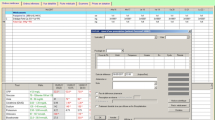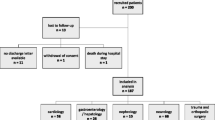Abstract
Purpose
To correct overdosing of drugs requiring adjustment based on renal function in intensive-care patients.
Methods
In a prospective intervention study, we estimated individual glomerular filtration rate and assessed whether medication required dose adjustment based on renal function. Senior clinicians received a structured report containing recommendations as to whether and how to adjust dosage in the individual patient (intervention). Prevalence of overdosed drugs (primary outcome), extent of overdoses, and reasons for nonacceptance of recommendations (secondary outcomes) were assessed.
Results
Of 138 screened intensive-care patients, 68 (49%) had renal impairment, and 110 (14%) of the 805 prescribed drugs required consideration of renal function. A potential overdose was found in 53/110 drugs (48%) and this rate decreased to 26/110 (24%, P < 0.001) after the intervention. The average extent of overdose was reduced from 54% before to 31% after the intervention (P < 0.001). The main reasons expressed by the physicians for nonacceptance of recommendations were a large therapeutic index or minor overdoses of the involved drugs.
Conclusions
In intensive-care patients, overdosing of drugs requiring adjustment based on renal function is still very common. Drug information counselling significantly decreased the prevalence and extent of overdose.


Similar content being viewed by others
References
Falconnier AD, Haefeli WE, Schoenenberger RA, Surber C, Martin-Facklam M (2001) Drug dosage in patients with renal failure optimized by immediate concurrent feedback. J Gen Intern Med 16:369–375
Chertow GM, Lee J, Kuperman GJ et al (2001) Guided medication dosing for inpatients with renal insufficiency. JAMA 286:2839–2844
Bergk V, Gasse C, Schnell R, Haefeli WE (2004) Requirements for a successful implementation of drug interaction information systems in general practice: results of a questionnaire survey in Germany. Eur J Clin Pharmacol 60:595–602
Martin-Facklam M, Rengelshausen J, Tayrouz Y et al (2005) Dose individualisation in patients with renal insufficiency: does drug labelling support optimal management? Eur J Clin Pharmacol 60:807–811
Levey AS, Bosch JP, Lewis JB et al (1999) A more accurate method to estimate glomerular filtration rate from serum creatinine: a new prediction equation. Modification of Diet in Renal Disease Study Group. Ann Intern Med 130:461–470
Wetzels JF, Kiemeney LA, Swinkels DW, Willems HL, den Heijer M (2007) Age- and gender-specific reference values of estimated GFR in Caucasians: the Nijmegen Biomedical Study. Kidney Int 72:632
Cockcroft DW, Gault MH (1976) Prediction of creatinine clearance from serum creatinine. Nephron 16:31–41
Dettli L (1983) The kidney in pre-clinical and clinical pharmacokinetics. Jpn J Clin Pharmacol Ther 15:241–54
Toto RD (1995) Conventional measurement of renal function utilizing serum creatinine, creatinine clearance, inulin and para-aminohippuric acid clearance. Curr Opin Nephrol Hypertens 4:503–509
Pestotnik SL, Classen DC, Evans RS et al (1993) Prospective surveillance of imipenem/cilastatin use and associated seizures using a hospital information system. Ann Pharmacother 27:497–501
Peterson JP, Colucci VJ, Schiff SE (1991) Using serum creatinine concentrations to screen for inappropriate dosage of renally eliminated drugs. Am J Hosp Pharm 48:1962–1964
Levey AS, Coresh J, Greene T et al (2007) Expressing the modification of diet in renal disease study equation for estimating glomerular filtration rate with standardized serum creatinine values. Clin Chem 53:766–772
Le Bricon T, Leblanc I, Benlakehal M, Gay-Bellile C, Erlich D, Boudaoud S (2005) Evaluation of renal function in intensive care: plasma cystatin C vs. creatinine and derived glomerular filtration rate estimates. Clin Chem Lab Med 43:953–957
Department of Clinical Pharmacology and Pharmacoepidemiology, University Heidelberg (2008) DOSING.de. http://www.dosing.de. Accessed 1 Jan–31 Mar 2008
Maschio G, Alberti D, Janin G et al (1996) Effect of the angiotensin-converting-enzyme inhibitor benazepril on the progression of chronic renal insufficiency. N Engl J Med 334:939–945
Debusmann ER, Pujadas JO, Lahn W (1987) Influence of renal function on the pharmacokinetics of ramipril (HOE 498). Am J Cardiol 59:70D–78D
Neubeck M, Fliser D, Pritsch M (1994) Pharmacokinetics and pharmacodynamics of lisinopril in advanced renal failure. Consequence of dose adjustment. Eur J Clin Pharmacol 46:537–543
Evans RS, Pestotnik SL, Classen DC et al (1998) A computer-assisted management program for antibiotics and other antiinfective agents. N Engl J Med 338:232–238
Rosborough TK, Shepherd MF, Couch PL (2005) Selecting an equation to estimate glomerular filtration rate for use in renal dosage adjustment of drugs in electronic patient record systems. Pharmacotherapy 25:823–830
Rind DM, Safran C, Phillips RS et al (1994) Effect of computer-based alerts on the treatment and outcomes of hospitalized patients. Arch Intern Med 154:1511–1517
Bates DW, Leape LL, Cullen DJ et al (1998) Effect of computerized physician order entry and a team intervention on prevention of serious medication errors. JAMA 280:1311–1316
Nebeker JR, Hoffman JM, Weir CR, Bennett CL, Hurdle JF (2005) High rates of adverse drug events in a highly computerized hospital. Arch Intern Med 165:1111–1116
Koppel R, Metlay JP, Cohen A et al (2005) Role of computerized physician order entry systems in facilitating medication errors. JAMA 293:1197–1203
Han YY, Carcillo JA, Venkataraman ST et al (2005) Unexpected increased mortality after implementation of a commercially sold computerized physician order entry system. Pediatrics 116:1506–1512
Jelliffe R (2008) Estimation of creatinine clearance. J Clin Pharmacol 48:1242–1244
Acknowledgements
We would like to thank all physicians on the ward for their helpful support in data collection. This work was funded by the University of Heidelberg. No conflicts of interest were present.
Author information
Authors and Affiliations
Corresponding author
Rights and permissions
About this article
Cite this article
Bertsche, T., Fleischer, M., Pfaff, J. et al. Pro-active provision of drug information as a technique to address overdosing in intensive-care patients with renal insufficiency. Eur J Clin Pharmacol 65, 823–829 (2009). https://doi.org/10.1007/s00228-009-0643-6
Received:
Accepted:
Published:
Issue Date:
DOI: https://doi.org/10.1007/s00228-009-0643-6




